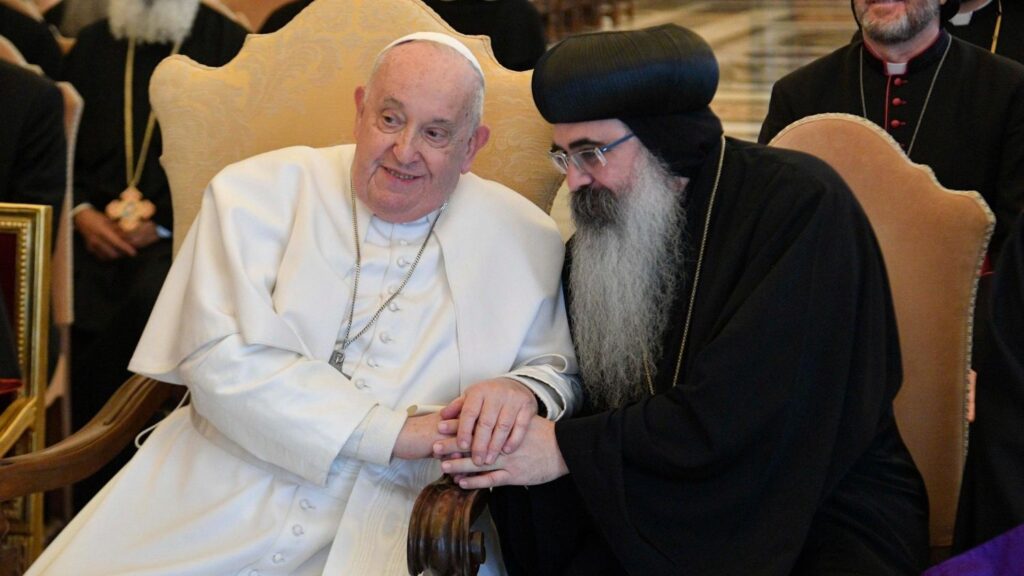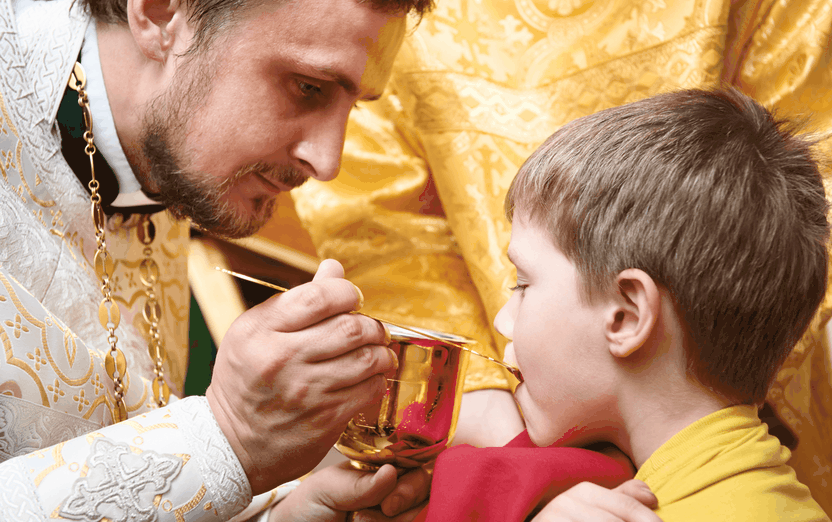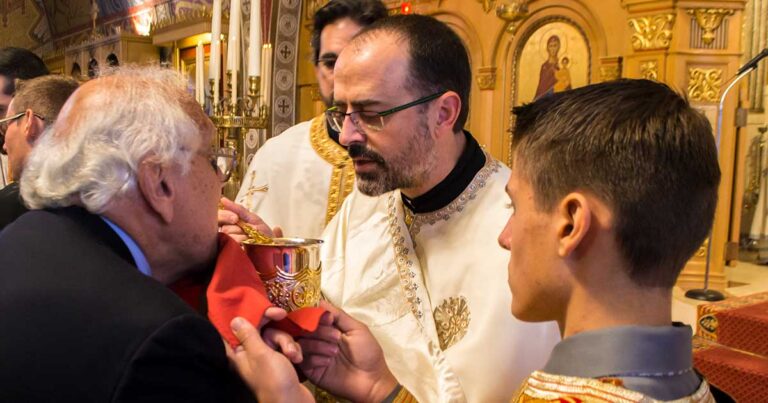No, In general, it is not encouraged for a Catholic to take communion in an Orthodox Church, and vice versa, due to differences in liturgical practices and theological perspectives. Both Catholic and Orthodox Churches have specific guidelines and canonical norms regarding communion, and individuals are usually expected to adhere to the practices of their tradition.
However, in some exceptional circumstances, with permission from the local bishop or priest, there may be room for certain allowances. It is recommended for individuals to consult with their local clergy and be aware of specific church policies before making a decision. Respect for the traditions and teachings of each church is essential in navigating such situations.
Communion in the Catholic Church

Communion, also known as the Holy Eucharist, is a central sacrament in the Catholic Church. It is one of the seven sacraments and holds significant theological and spiritual importance. Communion is considered the real presence of Jesus Christ in the form of bread and wine.
Here is an overview of how Communion is typically celebrated in the Catholic Church
Transubstantiation: The Catholic Church teaches the doctrine of transubstantiation, which means that during the consecration at Mass, the substance of bread and wine is changed into the body and blood of Jesus Christ, while the accidents (physical properties, like taste and appearance) remain unchanged.
The Mass: Communion is most commonly received during the celebration of the Mass, which is the central liturgical service in it. The Mass includes the Liturgy of the Word, where readings from the Bible are proclaimed, followed by the Liturgy of the Eucharist, where the bread and wine are consecrated.
Consecration: During the Liturgy of the Eucharist, the priest consecrates the bread and wine by repeating the words of Jesus at the Last Supper: “This is my body” for the bread and “This is my blood” for the wine. Catholics believe that, through the power of the Holy Spirit, the elements become the real presence of Christ.
Reception of Communion: After the consecration, the faithful receive Communion. The priest distributes the consecrated host (the body of Christ) to the communicants. In some cases, the consecrated wine (the blood of Christ) is also distributed. The act of receiving Communion is a moment of deep spiritual significance for Catholics.
Preparation: Before receiving Communion, Catholics are encouraged to prepare themselves through prayer, self-reflection, and the sacrament of reconciliation (confession) if necessary. The state of grace is essential for receiving Communion.
Frequency: Catholics are encouraged to receive Communion regularly, ideally during every Mass they attend. However, it is a personal decision, and some factors, such as being in a state of grace and observing the one-hour fast from food and drink before Communion, are to be considered.
Eucharistic Adoration: Outside of the Mass, some Catholic churches also have the practice of Eucharistic Adoration, where the consecrated host is displayed for worship, and the faithful can spend time in prayer and contemplation.
Communion in the Orthodox Church
Divine Liturgy: The central worship service in the Orthodox Church is called the Divine Liturgy. The Liturgy consists of two main parts: the Liturgy of the Word and the Liturgy of the Eucharist. The latter is the portion of the service directly related to the celebration of Communion.
Preparation: Before receiving Communion, Orthodox Christians are encouraged to prepare themselves through prayer, self-examination, and repentance. The sacrament of confession is an integral part of this preparation, and the faithful are encouraged to confess their sins to a priest before partaking in the Eucharist.
Consecration: During the Liturgy of the Eucharist, the priest consecrates the bread and wine by invoking the Holy Spirit and pronouncing the words of institution, similar to the words spoken by Jesus at the Last Supper. It holds to the belief in the real presence of Christ in the Eucharist, although the theological explanation may differ from that of the Catholic Church.
Reception of Communion: The consecrated elements, referred to as the Holy Gifts, are distributed to the faithful. The priest administers Communion using a special spoon, placing a small piece of the consecrated bread (prosphora) soaked in the consecrated wine (mixed with hot water) into the communicant’s mouth. The faithful usually approach the chalice with reverence, crossing their arms over their chest and tilting their head backward to receive the Eucharist.
Fasting: Similar to the Catholic Church, fasting is an important aspect of preparation for Communion in the Orthodox Church. They are expected to fast from midnight before receiving the Eucharist. This includes abstaining from food and drink (except water) during this period.
Frequency: They are encouraged to receive Communion regularly, ideally at every Divine Liturgy they attend. However, like in the Catholic Church, the frequency of Communion is a personal decision, and the faithful are urged to approach the sacrament with reverence and a proper spiritual disposition.
Eucharistic Adoration: While not as commonly practiced as in some Catholic traditions, the Orthodox Church also has moments of Eucharistic adoration, often in the context of special services or processions.
Differences between Catholic and Orthodox Communion
- Theological Differences:
- Transubstantiation vs. Divine Mystery: The Catholic Church officially teaches the doctrine of transubstantiation, which holds that the bread and wine change substance, becoming the actual body and blood of Christ. The Orthodox Church, while also affirming the real presence of Christ in the Eucharist, often uses the term “Divine Mystery” to express the transformation without delving into specific philosophical explanations.
- Liturgical Practices:
- Liturgical Language: The liturgical language varies between the two traditions. The Roman Catholic Church often celebrates Mass in the vernacular language of the local congregation, while the Orthodox Church may use liturgical languages like Greek, Church Slavonic, or other ancient languages.
- Leavened vs. Unleavened Bread: The use of leavened or unleavened bread in the Eucharist is different. The Catholic Church generally uses unleavened bread, while the Orthodox Church typically uses leavened bread, symbolizing the risen Christ.
- Fasting Practices:
- Fasting Before Communion: The duration and nature of the pre-Communion fast differ. In the Catholic Church, the fast is typically one hour before receiving Communion, while in the Orthodox Church, the fast is more extended, usually from midnight or a specified time the night before.
- Administration of Communion:
- Method of Distribution: While both traditions use a spoon for administering the Eucharist, there are variations in the specifics. In the Orthodox Church, the priest places a small piece of consecrated bread (prosphora) soaked in the consecrated wine into the communicant’s mouth using a spoon. In the Catholic Church, the communicant may receive the consecrated host directly on the tongue or in the hand, depending on local practices.
- Understanding of Authority:
- Papal Authority: One of the historical and theological issues that led to the Great Schism in 1054 was the question of papal authority. The Catholic Church recognizes the Pope as the supreme authority, while the Orthodox Church operates with a conciliar model, with no single bishop having universal jurisdiction.
- Ecclesiastical Differences:
- Organization and Structure: The organizational structure of the two churches differs. The Catholic Church is organized hierarchically, with the Pope at the top, followed by bishops, priests, and deacons. In the Orthodox Church, while there is a conciliar structure, there is no single figure equivalent to the Pope, and autocephalous (independent) Orthodox Churches are led by their primates.
Ecumenical Efforts and Agreements
- Second Vatican Council (1962-1965):
- The Second Vatican Council (Vatican II) was a significant ecumenical event initiated by the Catholic Church. One of its key documents, “Unitatis Redintegratio” (Decree on Ecumenism), encouraged dialogue and collaboration with other Christian traditions. It emphasized the importance of seeking unity among Christians and recognized the value of elements of truth and sanctification present in other Christian communities.
- Joint Declaration on the Doctrine of Justification (1999):
- The Lutheran World Federation and the Roman Catholic Church signed the Joint Declaration on the Doctrine of Justification. This agreement addressed historical doctrinal disagreements related to the understanding of justification, a central theological issue during the Protestant Reformation. The declaration expressed a common understanding on the topic, resolving some of the theological differences that had been sources of division.
- World Council of Churches (WCC):
- The World Council of Churches is an international organization that includes various Christian denominations and traditions. Its goal is to promote unity among Christian churches and facilitate cooperation on social, economic, and theological issues. While not all Christian traditions are members, the WCC has been an important platform for ecumenical dialogue and collaboration.
- Anglican-Roman Catholic International Commission (ARCIC):
- ARCIC is a series of theological dialogues between the Anglican Communion and the Catholic Church. The commission seeks to explore theological agreements and differences between the two traditions. While there have been challenges and ongoing discussions, these dialogues have contributed to greater understanding and cooperation.
- The Leuenberg Agreement (1973):
- The Leuenberg Agreement is a communion agreement among European Protestant churches. It emphasizes shared theological perspectives and allows for mutual recognition of ministries and sacraments among member churches, promoting a greater sense of unity among diverse Protestant traditions.
- Bilateral Agreements between Orthodox and Catholic Churches:
- There have been ongoing efforts between the Orthodox and Catholic Churches to address historical doctrinal and theological differences. While full unity has not been achieved, there have been joint statements and agreements on various theological issues, fostering a spirit of dialogue and mutual understanding.
Challenges and Controversies

- Doctrinal Differences:
- Fundamental theological differences, especially on issues such as the nature of the Eucharist, the role of the papacy, and the understanding of salvation, remain obstacles to full unity. These differences have historical roots and often represent centuries-old theological disagreements.
- Authority and Primacy:
- The question of authority, particularly the role of the pope in the Catholic Church, has been a source of tension. While the Catholic Church recognizes the pope as the supreme authority, many Orthodox Christians adhere to a conciliar model, where decisions are made collectively by councils of bishops.
- Interpretation of Tradition:
- Different Christian traditions often interpret and understand the early Christian tradition differently. Disagreements on matters of tradition, liturgy, and theology can hinder progress toward unity.
- Ethical and Moral Issues:
- Disagreements on ethical and moral issues, such as human sexuality and the sanctity of life, have created tensions among Christian denominations. These issues can be divisive and hinder collaboration on broader social and ethical challenges.
- Understanding of Sacraments:
- Variations in the understanding and administration of sacraments, such as baptism and the Eucharist, pose challenges. Differences in liturgical practices, including the form and meaning of sacraments, can create obstacles to unity.
- Cultural and Historical Baggage:
- Cultural and historical factors contribute to the challenges. The legacy of historical events, including the Great Schism of 1054 and the Protestant Reformation, has left lasting divisions and suspicions that persist in some communities.
- Challenges within Denominations:
- Even within individual Christian denominations, internal challenges and controversies can hinder efforts toward ecumenism. Different factions within a denomination may hold divergent views on ecumenical engagement.
- Interfaith Dialogue:
- The broader context of interfaith dialogue, including relations with non-Christian religions, presents additional challenges. Negotiating a common stance on interfaith engagement and understanding can be complex.
- Social and Political Factors:
- Social and political factors, both at the local and global levels, can impact ecumenical relations. Disputes over social issues, political affiliations, or historical grievances may spill over into ecumenical discussions.
- Ecclesiological Differences:
- Differences in ecclesiology, or the understanding of the nature and structure of the Church, can be a significant stumbling block. Different traditions may have distinct views on what constitutes the true Church.
FAQ’s
Are Catholics allowed to take Orthodox communion?
No, Orthodox churches generally do not permit Catholics to receive Holy Communion at their liturgies, despite occasional individual clergy members who might allow it.
Can a Catholic go to an Orthodox Church?
Yes,Catholics can attend Eastern Orthodox liturgies as guests, but these liturgies do not fulfill the Sunday/holy day obligation to attend Mass. Catholics are generally advised against receiving Communion at an Eastern Orthodox divine liturgy, although some exceptions exist.
Can a Catholic receive communion in a non-Catholic church?
No, the Catholic Church doesn’t permit Catholics to receive communion in churches not in union with the Catholic Church, according to canon law (canon 844 §1).
What is the Orthodox rule for communion?
In Orthodox practice, before receiving Communion, adherents should have been to Holy Confession beforehand. Also, prior to Communion, they should not brush their teeth, have breakfast, or consume milk or water.
Does the Orthodox Church recognize Catholic sacraments?
Yes, Both the Roman Catholic Church and the Eastern Orthodox Church recognize seven sacraments. The Roman Catholic Church acknowledges the validity of Eastern Orthodox Church sacraments. However, the Eastern Orthodox Church has reservations about certain Roman Catholic Church sacraments.
Final Words
Whether a Catholic can take communion in an Orthodox Church involves respecting the traditions of both faiths. Generally, it’s not encouraged due to differences, but exceptions may exist with permission.
Further, consulting local clergy is key to understanding specific church policies. Balancing unity and diversity, navigating this decision requires thoughtfulness and respect for each tradition’s sanctity.

